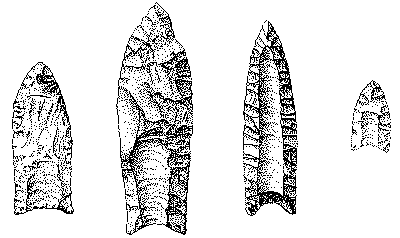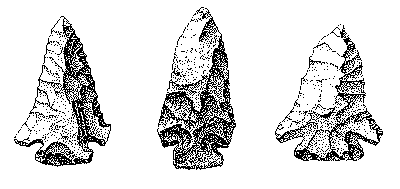Paleo-Indian Period
Paleo-Indian Period (12,000 – 6500 B.C.). The people who lived in Delaware during the Paleo-Indian time period were the region’s first human residents. Descendants of the first Asians to enter North America via the land bridge that linked Alaska and Siberia during the Ice Age, these nomadic hunters and gatherers wandered across the continent and arrived in Delaware at least 11,500 years ago. A site near Hockessin in northern Delaware has produced a radiocarbon date of approximately 9,500 B. C. and is one of the oldest well-dated sites in northeastern North America. At that time, large ice sheets still covered large portions of the North American continents north of the St. Lawrence River and the climate of Delaware was much colder and wetter than it is today. Spruce forests, deciduous forests, and some grasslands were mixed together in a hodge-podge distribution across the landscape at the beginning of this time period. By 10,000 years ago, spruce forests covered Delaware and were the dominant forest type until the end of the Paleo-Indian Period.
It is possible that some extinct large game animals such as mastodons and mammoths (distant relatives of modern elephants), horses, camels, and bison were present in Delaware and were hunted by Paleo-Indian groups using fluted points (See Figure A.) These kinds of points have been found in direct associations with extinct animals, including the mastodons and mammoths, in the western United States. However, some researchers feel that these species were extinct by the time that the first people came to Delaware, and that fluted points were used to hunt smaller, more modern game animals such as white-tail deer.

Figure A. Fluted points
No matter what they were used to hunt, fluted points are one part of stone tool kits that included a wide array of carefully made cutting and scraping tools used to process the hides, meat, and other resources obtained from game animals. Only the finest lithic raw materials were used. The Iron Hill area south of Newark is one local area where high quality jasper may be found and numerous fluted points have been found in this part of northwestern Delaware. Many Paleo-Indian sites are also known from the west central portion of the state where headwaters of rivers draining to the Delaware Bay meet the headwaters of those draining to the Chesapeake Bay. Studies of fossil pollen, which gives a clue to the kinds of ancient environments found in an area, have shown that this part of Delaware would have contained many poorly drained freshwater wetlands that were especially fruitful locales for hunters and gatherers to find food resources. It is surmised that small family groups of Paleo-Indians wandered between the good hunting locales in the central and southern part of the state and the places in northern Delaware where they could find the stone materials they needed to manufacture their tools. In many ways, Paleo-Indian groups were similar to Native American groups who still live in northeastern Canada, such as the Cree and the Naskapi-Montagnais. For these groups, highly mobile lifeways involving travel over hundreds of miles in the course of a year are preferred to more settled and sedentary existence.
Some time around 10,000 years ago, Paleo-Indian groups stopped making fluted projectile points and manufactured notched types such as the Palmer, Kirk, Charleston, and Amos varieties (See Figure B.) No one knows why this change occurred. Other parts of stone tool kits remained the same for another 1500 years, however.

Figure B. Charleston corner-notched points


